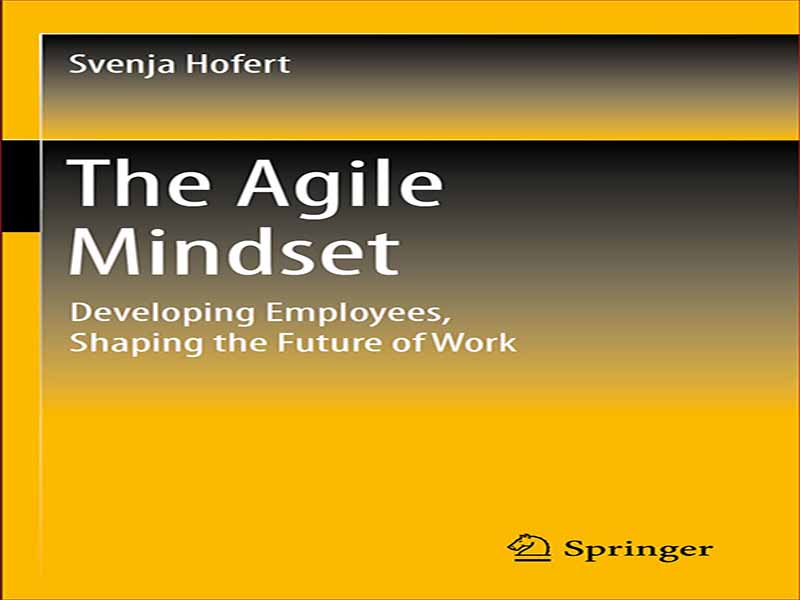- عنوان کتاب: The Agile Mindset: Developing Employees, Shaping the Future of Work
- نویسنده: Svenja Hofert
- حوزه: منابع انسانی
- سال انتشار: 2022
- تعداد صفحه: 234
- زبان اصلی: انگلیسی
- نوع فایل: pdf
- حجم فایل: 4.52 مگابایت
همه از طرز فکر صحبت می کنند. این باید با چابکی، با کار جدید – با نوع کار و رهبری که در این دوران پرتلاطم بسیار مد روز است، سازگار باشد. اما ذهنیت دقیقاً چیست؟ و یک طرز فکر به چه چیزی نیاز دارد، یعنی منطق فکر و عمل متناسب با محیط و شرکت چابک؟ به چالشهای ناشی از دیجیتالیسازی و تغییر فرهنگی که ناگزیر با آن همراه است، که هنوز همه از آن آگاه نیستند؟
قبل از توضیح بیشتر، میخواهم منظورم از «چابک» و «چابک» را در اینجا معرفی کنم، زیرا این را میتوان کاملاً متفاوت و در سطوح مختلف فهمید:
من مطمئن هستم که بیشتر وجود دارد. در این کتاب، ما به سطوح 1-3 علاقه مندیم. سطح 1 نقطه شروع برای سطوح 2-4 است که به نظر من واقعاً وجود ندارد. و سطح 5 به طور قابل توجهی بهتر عمل می کند (یا اصلاً به درستی) اگر سطوح 1-3 گنجانده شود.
با این شفاف سازی سریع، من نیز به نوعی موضع خود را معرفی می کنم.
با کتاب Agiler führen (رهبری چابک) به هزاران خواننده و بسیاری از تصمیم گیرندگان رسیده ام. یکی از دلایل اصلی این بود که موضوع را به صورت متمایز و با فاصله انتقادی مناسب مطرح کردم. من انجام ندادم 1. چابکی به عنوان یک فلسفه 2. چابکی به عنوان یک نگرش 3. چابکی به عنوان رویکردی برای مدیریت شرکتی 4. چابکی به عنوان رویکردی برای مدیریت پرسنل با تمرکز بر ارتقای تیم های خود سازماندهی شده 5. چابکی به عنوان یک چارچوب فرآیندی من متحد پیامبران چابکی هستم زیرا به وعده های نجات اعتقاد ندارم. من به این تجربه دست یافته ام که فردا هر شرکتی به تغییرات اساسی نیاز ندارد. بنابراین کاری کردم که مدتی در بازار کتاب چندان مورد توجه نبود. من به یک موضوع از جهات مختلف نگاه کردم و آن را در جنبه های مختلف آن ارائه کردم، بدون اینکه قصد داشته باشم رویکرد خود را به عنوان یک روش جدید تبلیغ کنم و روش خاصی را بفروشم.
شما می توانید از این کتاب انتظار همین رویکرد را داشته باشید. من به شما راه حل های آسان نمی دهم، این طرز فکر من نیست. با این حال، راهنمایی دریافت خواهید کرد که می توانید با آن و برای مدت طولانی، حتی فراتر از زمان تبلیغات، کارهای زیادی انجام دهید. از آنجا که چابکی مطمئناً دوباره کاهش می یابد، روندهای متضاد اعلام خواهند شد، و این در حال حاضر اتفاق می افتد. و چیز جدیدی وجود خواهد داشت، به احتمال زیاد چیزی که قبلا وجود داشته است. مدیریت مثل مد است.
من هم ممکن است یواشکی باشم. من موضوعی را از طریق چابکی معرفی می کنم که فقط یک بازار خاص برای آن وجود داشته است: توسعه نفس. این مدل تجربی ثابت می کند که افراد حتی در بزرگسالی نیز ذهنیت خود را به شیوه ای خاص توسعه می دهند. تنها مرحله معینی در این توسعه منطق تفکر و عمل باعث می شود که به طور مؤثر در یک خود سازماندهی کار کند یا فرآیندهای تغییر را هدایت کند. شرکت هایی که در مورد چابکی جدی هستند، باید افراد را به سمت مسئولیت پذیری خود پرورش دهند. به طور کلی، من فکر می کنم توسعه برای آینده کار محوری است. اگر ما تیلوریسم 2.0 را نمی خواهیم، مردم باید خود را با طرز تفکری که باید اساساً با تفکر عصر صنعتی متفاوت باشد وفق دهند. و نه فقط از نظر محتوا، بلکه از نظر ساختاری. به عبارت دیگر، دیگر افزایش دانش کافی نیست. ما به یک روش کاملاً متفاوت برای مقابله با آن نیاز داریم، یک روش جدید برای سازماندهی آن، شاید حتی باید بدون آن بیشتر و بیشتر عمل کنیم، زیرا هوش مصنوعی روز به روز بیشتر می شود.
Everyone is talking about mindset. It has to fit in with agility, with New Work – with the kind of work and leadership that is so trendy in these turbulent times. But what exactly is mindset? And what does a mindset require, i.e., a logic of thought and action that fits an agile environment and company? To the challenges posed by digitalization and the cultural change that inevitably accompanies it, of which not everyone is yet aware?
Before I elaborate further, I would like to introduce here what I mean by “agile” and “agility,” because this can be understood quite differently and on different levels:
I’m sure there are more. In this book, we are interested in levels 1–3. Level 1 is the starting point for levels 2–4, which do not really exist in my opinion. And level 5 works considerably better (or only properly at all) if levels 1–3 are included.
With that quick clarification, I am also introducing my stance in a way.
With the book Agiler führen (Agile Leadership), I have reached thousands of readers and many decision makers. One of the main reasons was that I presented the topic in a differentiated way and with an appropriate critical distance. I did not 1. Agility as a philosophy 2. Agility as an attitude 3. Agility as an approach to corporate management 4. Agility as an approach to personnel management with a focus on promoting self-organized teams 5. Agility as a process framework make myself an ally of agility prophets because I do not believe in promises of salvation. I have made the experience that not every company needs radical changes tomorrow. So I did something that was not very popular in the book market for a while. I looked at a topic from different directions and presented it in its different facets, without the intention of promoting one’s own approach as new and selling a particular method.
You can expect the same approach from this book. I will not give you easy solu¬tions, that is not my mindset. However, you will get a guide that you can do a lot with and for a long time, even beyond the time of the hype. Because agility will most certainly be scaled back again, counter trends will be proclaimed, and that is already happening. And there will be something new, most likely something that has already existed. Management is like fashion.
I may also be sneaky. I am introducing a topic via agility for which there has only been a niche market: ego development. This empirical model proves that peo¬ple develop their mindset in a certain way even in adulthood. Only a certain phase in this development of the logic of thinking and acting makes it possible to work effectively in a self-organization or to drive change processes. Companies that are serious about agility should develop people into self-responsibility. In general, I think development is central to the future of work. People have to adapt to a way of thinking that should be fundamentally different from the thinking of the industrial age if we do not want Taylorism 2.0. And not just in terms of content, but also structurally. In other words, it is no longer enough to ramp up knowledge. We need a completely different way of dealing with it, a new way of organizing it, perhaps we should even do without it more and more, since there is more and more artificial intelligence.
این کتاب را میتوانید از لینک زیر بصورت رایگان دانلود کنید:
Download: The Agile Mindset: Developing Employees, Shaping the Future of Work




































نظرات کاربران